The Unrealized Universality of Phrase Structure
An Analysis of Similarities Between Japanese and English

Learning a new language can be a daunting task for someone who only knows one language. New writing systems, sounds, vocabulary, and grammar are bare essentials to engage in discourse in a new language. Although it takes a considerable amount of time and effort to get the hang of a new language, it is not impossible. A new language may look as though it shares nothing in common with one’s native language, but that is very far from the truth. All languages share an abundance of features, and keeping those similarities in mind throughout the learning process helps ensure the right mindset to efficiently and effectively learn a language. In syntax, a subfield of linguistics, linguists focus on how and why humans piece together words to form phrases and phrases to form sentences that are unique to that person and language but, at the same time, exhibit regular patterns that many languages share. This work is done by analyzing example sentences from a language and looking for patterns in the way words, or lexical items, are used together. So, despite Japanese and English having emerged from completely different parts of the world and having had little contact with each other, a syntactical analysis of the two languages reveals similarities regarding phrasal elements and phrase structure.
Keywords: lexicon, lexical restriction, head-initial/ final, transformation, word order
Introduction
Japan is alluring to many foreigners. Possibly because of anime, the unique and deep-rooted Japanese culture, business opportunities, or even curiosity, they want to travel to Japan, engage in the culture, and learn the language. Though the language may seem extremely difficult or too different to be learned fluently by foreigners, underneath the unfamiliar characters and sounds lie similar phrasal components and speech patterns. The meaning that those components and patterns convey make Japanese a language not much different from English.
The Field of Linguistics
The field of linguistics facilitates a systematic comparison between languages. Even more broadly speaking, a linguist’s goal is to explain the phenomenon known as language. Conducting field work to acquire data and analyzing pieces of that data to draw conclusions are common methods used by linguists during their research. As with other major sciences, linguistics includes many subfields that investigate more specific aspects of language. One major subfield is syntax, which focuses on how a person combines words, or lexical items, to form their own unique phrases and how these phrases form complete sentences.
The mental lexicon consists of many categories, some of which are familiar; nouns, adjectives, adverbs, verbs, and prepositions are a few major lexical categories that serve as a base for the sentences that we as humans naturally formulate whenever we want to express ourselves (Freidin, 2012). It is the job of a syntactician to determine the rules that govern how we piece lexical items together. Syntacticians typically start with a grammaticality judgement test as a preliminary method of proving these rules are legitimate. Any native speaker of a language can do the same, for example, when comparing “my color favorite is green” with “my favorite color is green.” English language speakers and learners will recognize that the second example is grammatical. Although grammaticality tests seem simple, they are in fact extremely important in maintaining the validity of syntacticians’ work.
When learning a language, using slang or “incorrect grammar” may be a concern; however, a syntactician is not concerned with the minute stylistic preferences that are often taught in English courses. Rules concerning style or formality are what linguists consider prescriptive grammar. Instead, linguists in the syntax subfield focus on modelling the grammatical rules that guide the everyday computation of words and phrases that people acquire as part of their linguistic maturation (a process that is mostly complete before adulthood), also known as descriptive grammar (Freidin, 2012). Although some utterances may feel “too casual” or “incorrect,” they may in fact be grammatical. Comparing those same utterances to similar ones using similar words, or lexical items, can unveil a pattern or rule. When comparing English and Japanese, using example sentences and phrases that follow descriptive, not prescriptive, grammar is key.
Origins of Japanese
In order to understand how uncoincidental the similarities between Japanese and English are, it is important to have some context concerning their origins. Japanese, unlike English, does not belong to the large Indo-European language family which dominates the majority of the world. Instead, Japanese developed from the Japonic language family, consisting of Japanese and Ryukyuan, both close in proximity and isolated to a very small area. Moreover, because the Japanese people lived in isolation for so long, their language experienced little outside influence (Shimoji, 2010). Japan’s long period of isolation may have fueled general interest when Japan opened up to the world. English, meanwhile, has seen its fair share of change and interaction over time.
In order to establish similarities between Japanese and English sentence structures, comparing sentences utilizing words with the same or similar meaning, as shown below in section (A), offers an initial step.
A. Japanese Lexicon (and Abbreviations Used in Example Glosses and Tree Structures)
Determiners (D):
| kono | ‘this’ |
Particles (Prt):
| ga | subject (Subj) marker |
| o | direct object (Obj) marker |
| ni | directional marker (‘to’ or ‘in’) |
| de | locational/ instrumental marker (‘at’ or ‘with’) |
| to | ‘with’ |
| kara | ‘from’ |
Nouns (N):
| saru | ‘monkey’ |
| tegami | ‘letter’ |
| tsuma | ‘wife’ |
| ondori | ‘rooster’ |
| sensei | ‘teacher’ |
| kodomo | ‘child’ |
| tokyo | ‘tokyo’ |
| kawa | ‘river’ |
| hon | ‘book’ |
| kobe | ‘kobe’ |
| kuruma | ‘car’ |
Adjectives (A):
| ureshii | ‘happy’ |
Intensifiers (Int):
| totemo | ‘very’ |
Verbs (V):
| kita | ‘came’ |
| shinda | ‘died’ |
| oyoida | ‘swam’ |
| butta | ‘hit’ |
| yonda | ‘read’ |
| shikatta | ‘scolded’ |
| itta | ‘went’ |
| atta | ‘met’ |
| mita | ‘saw’ |
| yatta | ‘gave’ |
Sentence Structure
The broadest observable similarity between Japanese and English is at the sentence level; both languages feature a noun phrase (NP) followed by a verb phrase (VP), as in sentence (1).
1. Saru ga kita
monkey Subj-Prt came
‘The monkey came.’
Furthermore, sentence (2) shows that Japanese sentences are ordered as followed: subject, object, verb (SOV); English is ordered subject, verb, object (SVO). To distinguish between the subject and object in Japanese (since they are not separated by the verb), the particle ga marks subjects (Subj-Prt) and o marks objects (Obj-Prt), as shown in sentence (2).
2. sensei ga kono kodomo o shikatta
teacher subj-prt this child obj scolded
‘The teacher scolded this child’
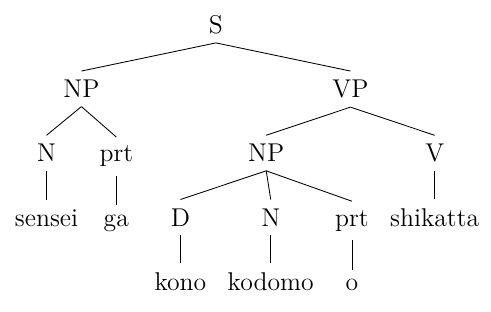
Though the order of Japanese and English sentences differs overall, similarities lie within. Some Japanese particles share the same function as English prepositions (e.g., kuruma de ‘in the car’; see section (A) for more examples). What’s more, the location of the characteristic components of a phrase (also known as the head) is consistent in all phrases within English and Japanese, respectively (Freidin, 2012). Languages like English are called head initial while Japanese is head final. In an English verb phrase, the V-head precedes the object; in a Japanese verb phrase, the V-head follows the object. In both languages, however, information directly related to the verb is closer to it than information that is only loosely related to the verb. This makes the sentence easier to process (see sentence (5)).
Similarities at the Noun Phrase Level
Nouns are not the only component of a noun phrase (NP). Other possible elements of a Japanese NP are a determiner (D) and an adjective phrase (AP). A determiner can denote many functions such as definiteness (how well known a noun is to a listener), ownership, or spatial relation (how close a noun is to a speaker). An example of a Japanese determiner shown in sentence (2) and again in sentence (3) is kono ‘this,’ referring to a noun that is close to the speaker.
3. kono totemo ureshii saru ga kawa de oyoida
this very happy monkey subj-prt river in swam
‘This very happy monkey swam in the river’
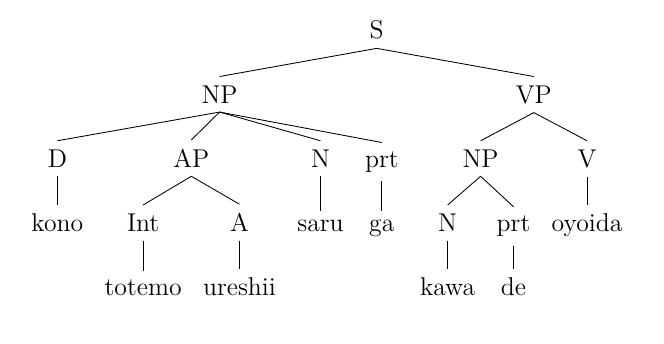
Not only is the function and meaning of kono the same as its English counterpart, its location in the NP is also exactly the same. On the note of adjectives, Japanese has an AP just like English featuring an optional intensifier (Int) (n.b., intensifiEer is another word for an adverb that comes before an adjective to strengthen its meaning) followed by a mandatory adjective. Yet another similarity shared by both languages is that an AP always precedes a noun to modify it, as shown in sentence (3). All things considered, the D-AP-N sequence in the Japanese NP rule in section (B) is identical to the English one (see also Felt, this issue).[1]
The next example introduces a new particle, no.
4. saru no atama ga ondori no atama to butsukatta
monkey GN head subj-prt rooster GN head with collided
‘The monkeys head collided with the roosters head’
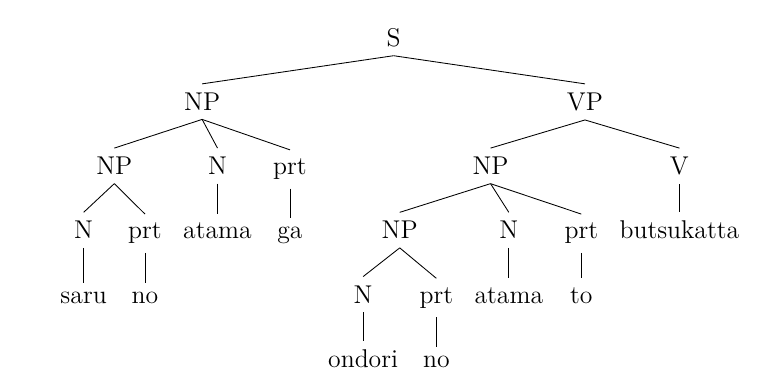
It is clear that no marks the noun before it as possessor rather than the noun after it, given the translation in sentence (4), (e.g., saru no… ‘the monkey’s…’). This is consistent with the subject and object particles coming after their nouns at the end of the phrase, as well. That said, it is important to note that saru no is a whole possessor NP modifying the N-head of the phrase, the possessee. Thus, it would seem that not all NPs in Japanese are in subject or object position. Instead, an NP can additionally be embedded inside another NP, similar to how an English NP can be embedded inside another using the possessive clitic ‘s (Freidin, 2012).
Similarities at the Verb Phrase Level
At first glance, Japanese verb phrases (VPs) are a stark contrast to English VPs. The primary reasons for this are that Japanese VPs end with the verb and that Japanese lacks prepositional phrases (PPs). Yet, Japanese particles can function as prepositions, so Japanese noun phrases have the same potential as English PPs. There are instances in English when a verb needs a certain other phrase to complement it. We use a lexical restriction to define what specific lexical element(s) can or cannot be used. For example, in sentence (5), “went” has to co-occur with a directional PP like ‘to Kobe’ (n.b., the other PPs are extra information).
5. saru ga ondori to kuruma de kobe ni itta
Monkey subj-prt rooster with car in kobe to went
‘The monkey went to kobe in a car with the rooster’
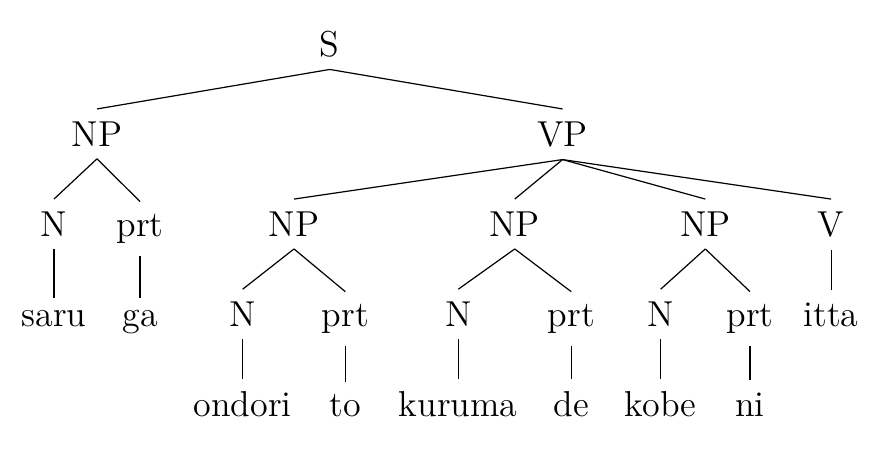
Japanese has the same exact lexical restriction; the only noteworthy difference is that a PP in English is an NP in Japanese, and, again, the English V comes before the PP, while the Japanese V comes after the NP. In addition, the required phrase (here the directional PP/NP) is closer to the verb than the other non-essential phrases within the predicate, both in English and Japanese. An example of how a lexical restriction is expressed is provided in section (C).
Beyond the lack of a whole string of auxiliary verb options (see Felt, this issue), Japanese VPs only substantively differ from their English counterparts in the order of their phrase head with respect to modifying phrases. Again, the Japanese VP is head-final, while the English VP is head-initial.
A’. Japanese Lexicon Additions
Particles (Prt):
| no | ‘of’/possessive marker |
Nouns (N):
| otoosan | ‘father’ |
| kodomo | ‘child’ |
| atama | ‘head’ |
Verbs (V):
| butsukatta | ‘collided’ |
B. Japanese Phrase Structure Rules
S → NP VP
NP → N prt
AP → (Int) (A)
VP → (NP)* V[2]
C. Japanese Lexical Restrictions and English Counterparts
| Japanese | English |
| yatta ‘gave’, [NP[ni] NP_] | give, [_NP PP[to]] |
| Itta ‘went’, [NP[ni]_] | go, [_PP[to]] |
Transformation Possibilities
In all the previous examples, the elements of a Japanese sentence followed an apparently strict word order pattern. However, sentences (6)–(8) demonstrate how any NP modifying the verb can move in front of any other phrase (including the subject) in the sentence.
6. ondori to wa saru ga kuruma de kobe ni itta
rooster with subj-prt monkey topic-prt car in kobe to went
‘The monkey went to kobe in a car with a monkey’
7. kuruma de wa saru ga ondori to kobe ni itta
car in subj-prt monkey topic-prt rooster with kobe to went
‘The monkey went to kobe in a car with a monkey’
8. kobe ni wa saru ga ondori to kuruma de itta
kobe to subj-prt monkey topic-prt rooster with car in went
‘The monkey went to kobe in a car with a monkey’
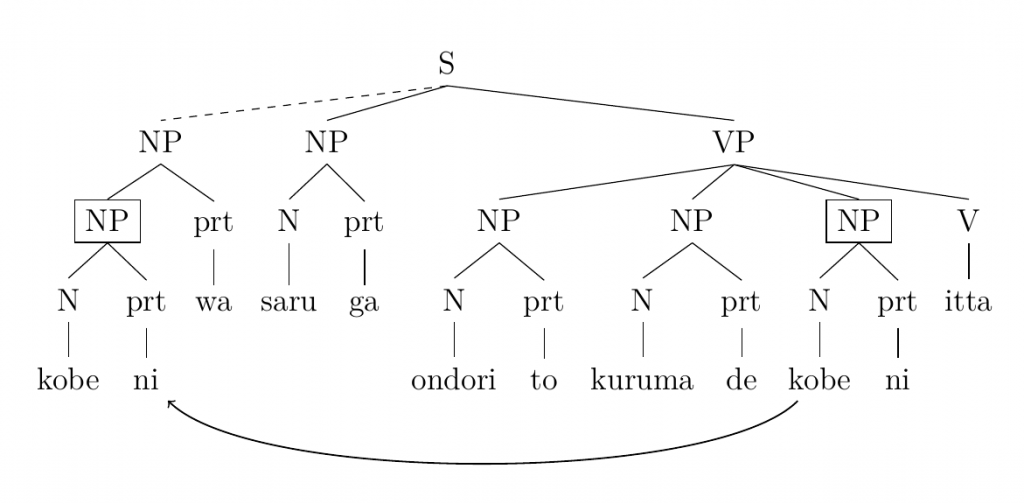
The wa insertion rule stated in section (D) accounts for this nuance, and although the translations in the example set do not directly represent this, a wa insertion puts extra emphasis on the moved phrase. This has an effect identical to an English rule called PP/NP fronting, which defines how a speaker can move part or all of a sentence’s final prepositional phrase to the beginning of the sentence to draw attention to it. But in English, PP/NP fronting is not used as often as fronting a wa-marked phrase in Japanese which makes learning Japanese (hearing and comprehending the nuance) difficult for English speakers, who are accustomed to a stricter word ordering.
A”. Japanese Lexicon Addition
- Particle
- wa ‘as for’/ focus shift
D. Japanese Transformation Rule
- Wa insertion and NP-fronting:
- Move NP to be emphasized to front of sentence
- Insert wa after particle of moved NP
Conclusion
As the above comparisons show, Japanese and English are very similar. Aside from using different writing systems and sounds, Japanese shares many syntactic features with English. The way words in phrases are ordered and combined is virtually the same; the only immediately obvious difference is that in VPs, Japanese object-verb (OV) order is the mirror image of English verb-object (VO) order. In every phrase of both languages, essential information (the complement) is closer to the head than other, less important modifiers. As a result, when using similar lexical items in Japanese and English, the derived sentences will convey meaning akin to each other, and their word order will retain a similar structure. Ultimately, English speakers learning Japanese will be well served by noting this common ground to overcome the surface-level observation that the two languages are entirely different.
References
Freidin, R. (2012). Syntax: Basic concepts and applications. Cambridge: Cambridge Univ. Press.
Shimoji, M., & Pellard, T. (2010). An introduction to Ryukyuan languages. Fuchu(Tokyo-to): Research Institute for Languages and Cultures of Asia and Africa.
Notes
[1] This is so despite English generally being a head-initial language and Japanese being a head-final language. In NPs, we only see this difference if we add a complement to the noun, as in, the teacher of Japanese, where the of-phrase follows the N teacher. In Japanese, the complement precedes the N.
[2] The notation (…)* means the phrase in the parentheses can be repeated indefinitely.
Acknowledgements: I would like to give thanks to my syntax professor, Dr. Vera-Lee Schoenfeld, as well as my Japanese sensei, Yuki Sasaki Caldwell, for their teachings that served as a basis for majority of the discussion in this paper.